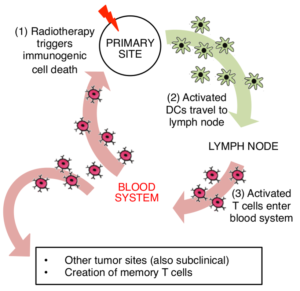Synergy of radiation and immune system

Animal studies and clinical trials identified a synergy of fractionated irradiation and immunotherapy. This synergy stems from the fact that radiation induces cell stress and immunogenic cell death, thereby exposing a wealth of previously hidden tumor-associated antigens, stress proteins and dangerassociated molecular patterns (HSPs, DAMPs), which are endogenous immune adjuvants that can initiate and stimulate an immune response. Dendritic cells recognize these antigens, and present them to activate naïve T cells in the tumor draining lymph node. Activated T cells then travel through the lymphatic system, nter the blood circulation, and travel in cycles with the blood through the system of rteries, capillaries and veins. Post-irradiation immunotherapy stimulates rapid growth, proliferation, and differentiation of dendritic cells or T cells that are capable of specific imination of antigen-presenting tumor cell, thereby facilitating a second wave of cell kill nd overall tumor regression. Different radiation fractionation protocols in combination ith various immunotherapeutic approaches are currently being explored in more than 10 active clinical trials (7).
The goal of the project is to develop a quantitative mathematical framework that predicts systemic response of metastatic tumors to focal radiotherapy – either alone or in combination with immunotherapy. The ultimate aim of this project will be to propose such framework as a clinical decision support system to derive optimal radiation fractionation protocols and irradiation site for immune activation on a per patient basis.
